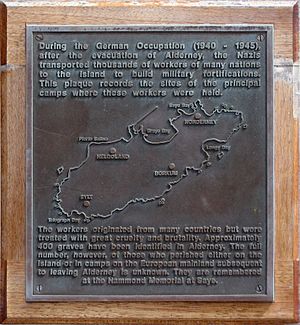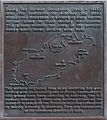Alderney concentration camps facts for kids
The Alderney concentration camps were special prisons built by Nazi Germany during World War II. These camps were located on Alderney Island, which is one of the Channel Islands. The Channel Islands were the only part of the British Commonwealth that the Nazis took over during the war.
The Nazis built four main camps on Alderney. They were like smaller parts of a much larger camp called Neuengamme near Hamburg, Germany. Each camp was named after a Frisian Island: Lager Norderney, Lager Borkum, Lager Sylt, and Lager Helgoland. A Nazi group called the Organisation Todt ran these camps. They used forced labour to build strong bunkers, places for guns, air-raid shelters, and other concrete defenses. The camps started in January 1942 and held about 6,000 people in total.
Contents
What Were the Camps Like?
The camps on Alderney were not all the same. Some were slightly less harsh than others, but all were very difficult places to be.
Borkum and Helgoland Camps
The Borkum and Helgoland camps were for people who were called "volunteers." Even though they were called volunteers, these workers were still treated very badly. They had to work hard and live in tough conditions. Lager Borkum held German technicians and people from different parts of Europe. Lager Helgoland was mainly for Russian workers who were part of the Organisation Todt.
Sylt and Norderney Camps
The Sylt and Norderney camps were much worse. The people held here were slave labourers. They were forced to build many military buildings and defenses all over Alderney. Lager Sylt held Jewish people who were forced to work. Norderney camp held people from other parts of Europe, especially Eastern Europe, and also Russian prisoners.
Who Was in Charge?
In 1942, the Lager Norderney and Lager Sylt camps were put under the control of a Nazi officer named Max List. These camps held Russian and Polish prisoners of war, as well as Jewish people. Sadly, more than 700 people died in these camps. The camps were finally closed in 1944, and the people who were still alive were moved to other Nazi camps in Germany.
Images for kids




